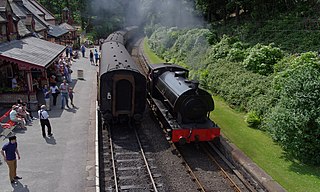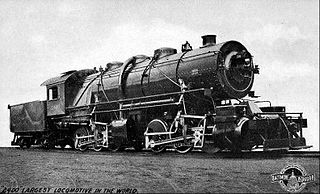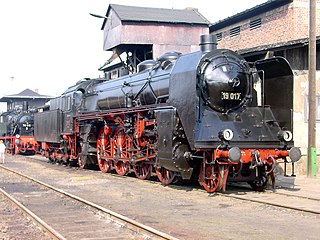
The Lakeside and Haverthwaite Railway (L&HR) is a 3.2-mile-long (5.1 km) heritage railway in Cumbria, England.

The National Railway Museum (NRM) is a museum in York, England, forming part of the Science Museum Group. The museum tells the story of rail transport in Britain and its impact on society. It is the home of the national collection of historically significant railway vehicles such as Mallard, Stirling Single, Duchess of Hamilton and a Japanese bullet train. In addition, the National Railway Museum holds a diverse collection of other objects, from a household recipe book used in George Stephenson's house to film showing a "never-stop railway" developed for the British Empire Exhibition. It has won many awards, including the European Museum of the Year Award in 2001.

Under the Whyte notation for the classification of steam locomotives, 0-4-0 represents one of the simplest possible types, that with two axles and four coupled wheels, all of which are driven. The wheels on the earliest four-coupled locomotives were connected by a single gear wheel, but from 1825 the wheels were usually connected with coupling rods to form a single driven set.

The Furness Railway (Furness) was a railway company operating in the Furness area of Lancashire in North West England.

The locomotive Saxonia was operated by the Leipzig–Dresden Railway Company and was the first practical working steam locomotive built in Germany. Its name means Saxony in Latin.

The Cumbrian Coast line is a rail route in North West England, running from Carlisle to Barrow-in-Furness via Workington and Whitehaven. The line forms part of Network Rail route NW 4033, which continues via Ulverston and Grange-over-Sands to Carnforth, where it connects with the West Coast Main Line.

Under the Whyte notation for the classification of steam locomotives, 2-4-0 represents the wheel arrangement of two leading wheels on one axle, four powered and coupled driving wheels on two axles and no trailing wheels. In most of North America it became known as a Porter.

Under the Whyte notation for the classification of steam locomotives, a 0-6-6-0 wheel arrangement refers to a locomotive with two engine units mounted under a rigid locomotive frame, with the front engine unit pivoting and each engine unit with six coupled driving wheels without any leading or trailing wheels. The wheel arrangement was mostly used to describe Mallet locomotive types and in some occasions, Double Fairlie locomotives.

The Midland Railway 1377 Class was a class of 185 0-6-0T tank locomotives. They were introduced in 1878 by Samuel W. Johnson, and were almost identical to the 1102 class of 1874; the latter having fully enclosed cabs, while the 1377 class were built without a rear to the cab and only a short cab roof, hence their nickname "half-cabs". They were given the power classification 1F.
The Furness Railway Company owned many different types of locomotives, built by several locomotive building companies, including Sharp, Stewart and Company. Others were built by the Furness' constituent companies - the Whitehaven and Furness Junction Railway, among others.

Bury, Curtis and Kennedy was a steam locomotive manufacturer in Liverpool, England.

The Bury Bar Frame locomotive was an early type of steam locomotive, developed at the Liverpool works of Edward Bury and Company, later named Bury, Curtis, and Kennedy in 1842. By the 1830s, the railway locomotive had evolved into three basic types - those developed by Robert Stephenson, Timothy Hackworth and Edward Bury.

The Saxon Class XX HV were German eight-coupled express train, tender locomotives built for the Royal Saxon State Railways just after the First World War. The locomotives, which became known as the 'Pride of Saxony' (Sachsenstolz) were the first and only German express locomotives with a 2-8-2 wheel arrangement and, at the time of their appearance, were the largest express engines in the whole of Europe. In 1925, the Deutsche Reichsbahn grouped these locomotive into their DRG Class 19.0.
The DRESDEN to RIESA series of early German steam engines, were tender locomotives operated by the Leipzig–Dresden Railway Company (LDE).
The EDWARD BURY to PFEIL series of early German locomotives were tender engines operated by the Leipzig–Dresden Railway Company.
The Saxon Class VIa were early Germany steam engines operated by the Royal Saxon State Railways. The class included various types of fast-stopping train (Eilzug) locomotive, which had originally come from the Leipzig–Dresden Railway Company and the Eastern State Railway.
The MOLDAU to MULDE series of early, German steam engines were designed as tender locomotives for the Leipzig–Dresden Railway Company for mixed duties.

A haycock boiler is an early form of steam locomotive boiler with a prominently raised firebox of "Gothic arch", "haystack", or "coppernob" shape. The term haystack is most commonly used, but is avoided here as it is confusingly used for three quite different forms of boiler. This particularly large outer firebox served as the steam dome and was often highly decorated with polished brass. These were popular for early railway locomotives, from 1840 to the 1850s.
Carnforth MPD (Motive Power Depot) is a former London Midland and Scottish Railway railway depot located in the town of Carnforth, Lancashire, England.

The Saxon Class VII T were twin-coupled tank engines of the Royal Saxon State Railways designed for branch line (Sekundärbahn) operations. In 1925, the Deutsche Reichsbahn grouped these locomotives 1925 into their Class 98.70.















